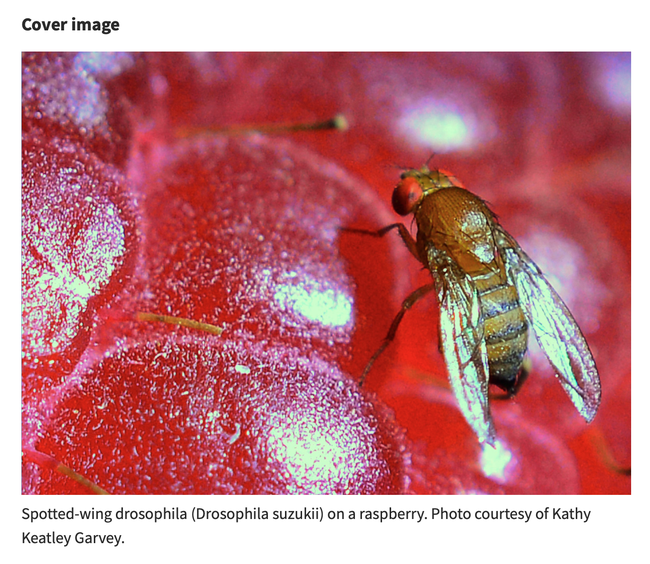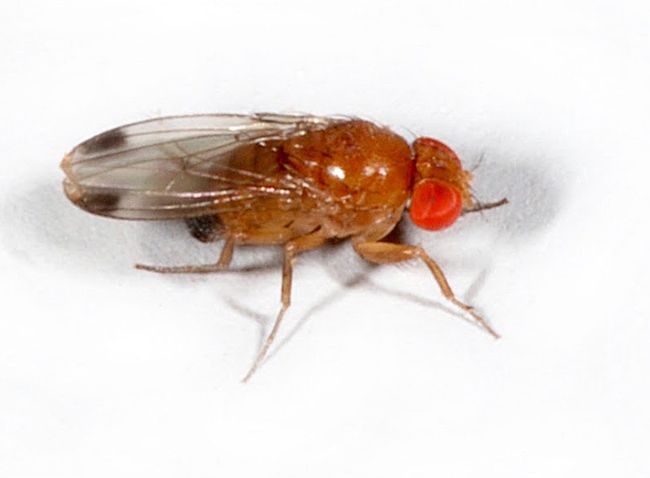- Author: Kathy Keatley Garvey

Native to Asia, the agricultural pest is a worldwide threat to the berry production industry, which includes raspberries, blackberries, blueberries, strawberries, and cherries. The tiny insect, about 1/12 to 1/8 inch long, invaded the continental United States in 2008.
“All of the papers were by invitation of the co-editors of the special collection—Jana Lee, Cesar Rodrigue-Saona, and me,” said journal editor-in-chief Frank Zalom, a UC Davis distinguished professor emeritus and recall professor in the Department of Entomology and Nematology. Zalom's research includes the spotted-wing drosophila.
Lee, formerly with the UC Davis laboratory of the late chemical ecologist Steve Seybold, is a research entomologist with the Horticultural Crops Research Unit, U. S. Department of Agriculture, Agricultural Research Service, Corvallis. Rodriguez-Saona, who received his doctorate from UC Riverside, is an Extension entomologist with the Department of Entomology, Rutgers University, the State University of New Jersey.
In addition to Zalom and Lee, the UC Davis-linked authors include Joanna Chiu and Antoine Abrieux (Joanna Chiu lab); Zain Syed and Kevin Cloonan (Walter Leal lab); Gregory Loeb (Rick Karban lab); and Kelly Hamby, Hannah Burrack, Fatemeh Ganjisaffar, Brian Gress, Nicole Nicola and Mark Demkovich (Zalom lab).
Overall, the Special Collection includes authors from Austria, Brazil, Canada, Italy, Spain, Sweden, United Kingdom, and the United States that represent perspectives from universities, federal and state laboratories, growers, and pest product companies, according to the editors.

UC Davis Department of Entomology and Nematology communication specialist Kathy Keatley Garvey provided the cover photo of the spotted-wing drosophila feeding on a raspberry.
Since 2008, "D. suzukii has become a key economical pest of raspberries, blackberries, blueberries, strawberries, and cherries in the United States and worldwide," the editors wrote in their introductory remarks. "Not surprisingly, the number of publications has proliferated from 29 publications as of 2010 to 978 additional publications between 2011 and 2021 from a Web of Science search for ‘Drosophila suzukii.' While many publications are available, this special collection will highlight advances in D. suzukii pest management since its U.S. invasion. We solicited papers by open call and received 66 abstracts, and selected 14 papers covering: 1) review, 2) monitoring and risk, 3) behavioral control, 4) biological control, 5) cultural control, and 6) chemical control."
The editors pointed out that “Given that 14 years of research has accumulated since the continental U.S. invasion, it was fitting to include two reviews that provide a different scope than was covered in prior reviews on D. suzukii biological control (Lee et al. 2019, Wang et al. 2020), trapping (Burrack et al. 2020), cultural control (Schöneberg et al. 2021), and chemical ecology (Cloonan et al. 2018). This special collection is anchored by Tait et al. (2021), a review of the most promising methods as part of an Integrated Pest Management (IPM) strategy against D. suzukii across the world since 2008. The effectiveness, impact, sustainability, and present stage of development and implementation are discussed for each of the considered techniques, and insights for continued development are presented.”
“A second review in this special collection by Garcia et al. (2022) summarizes the history and current status of D. suzukii in Latin America. The authors first provide a history of the D. suzukii invasion through Latin American countries, which started in 2011 in Mexico, and is now present in Argentina, Brazil, Chile, and Uruguay. They describe the host plants where D. suzukii has been found as well as advances in monitoring, biological control, chemical control, cultural control, and in the sterile insect technique. The authors posit that this information can serve as the basis for developing sustainable area-wide management programs in Latin America.”
The researchers related that the pest is a significant threat to California's berry production industry, which the California Department of Food and Agriculture (CDFA) valued at more than $2.8 billion in 2019. Caneberries, in particular, "are a preferred host of D. suzukii, and California accounts for 89.4 percent of all production in the United States, with the Monterey Bay region producing about half of the state's raspberries and blackberries (CDFA 2020). This pest has now spread to all major berry and cherry growing areas of the United States."
The collection is meant to serve "as a key reference point for entomologists across many institutions (e.g., academia, government, and industry) on important advances in D. suzukii pest management," according to the Entomological Society of America. "The articles in this collection will also provide scientists information on potential research gaps that will help guide future research directions on this important pest. The goal is to preserve and catalog articles on various aspects of D. suzukii pest management, i.e., monitoring, cultural control, chemical control, behavioral control, and biological control, that will be shared among entomologists."

- Author: Kathy Keatley Garvey

The seminar, part of the UC Davis Department of Entomology and Nematology's weekly fall seminars, begins at 4:10 p.m. The Zoom link: http://ucdavis.zoom.us/j/99515291076.
"Since its 2008 detection in North America, management of the invasive Drosophila suzukii has primarily relied on calendar insecticide applications, creating a scenario where selection pressure from frequent insecticide
applications could result in development of insecticide resistance," Ganjisaffar says in her abstract.
"Field-derived resistance to spinosad has already been documented in California caneberry production, and there is significant concern among berry and cherry growers for development of resistance to other insecticides," she wrote. "This seminar will present the status of our ongoing studies to assess development and extent of insecticide resistance in California D. suzukii populations, seasonal changes in resistance, stability of resistance and potential cross-resistance between chemical classes, as well as our work on the behavioral control of D. suzukii and evaluating the efficacy of some Attract-and-Kill products."
Ganjisaffar joined the Zalom lab in August 2020 from UC Riverside where she served as a postdoctoral scholar after receiving her doctorate in entomology there in 2016. She was a member of the UC Riverside team that won second place in theESA's Linnaean Games (now Entomology Games). She received a University of California Dean's Distinguished fellowship in 2011.
Zalom, a UC Davis distinguished professor of entomology, is a past president of the Entomological Society of America (ESA) and was recently named Honorary Member of ESA, the organization's highest honor.
Ganjisaffar holds a bachelor's degree in agricultural engineering/plant protection (2006) from the University of Tehran, Tehran, Iran, and a master's degree in agricultural entomology (2009) from Tarbiat Modares University, Tehran.
Her most recent publications include:
- Life History Evaluation of Ooencyrtus lucidus, a Newly Described Egg Parasitoid of Bagrada hilaris
Journal, Insects, May 9, 2020 - Lethal and Sub-Lethal Effects of Insecticides on the Pink Hibiscus Mealybug, Maconellicoccus hirsutus (Hemiptera: Pseudococcidae)
Journal, Insects, - Mutual interference between adult females of Galendromus flumenis (Acari: Phytoseiidae) feeding on eggs of Banks grass mite decreases predation efficiency and increases emigration rate
Experimental and Applied Acarology,
The UC Davis Department of Entomology and Nematology seminars are held on Wednesdays at 4:10 p.m. All in-person seminars are held in 122 Briggs Hall, while the virtual seminars are broadcast on Zoom. For more information, contact coordinator Shahid Siddique, nematologist and assistant professor, at ssiddique@ucdavis.edu.

- Author: Kathy Keatley Garvey

"Unlike common drosophilids that develop in rotten or decaying fruit, Drosophila suzukii (Matsumura) prefer to oviposit in ripe or ripening fruit," Hamby says in her abstract. "Native to Southeast Asia, D. suzukii has become an important pest of berries and small fruits throughout North America and Europe since its initial detection in Santa Cruz County, Calif. in 2008. The majority of U.S. organic berry farm acreage is concentrated on the west coast, and organic berries are a growing industry that now exceeds 1500 total farms. Current D. suzukii management strategies for both organic and conventional growers rely heavily on insecticide usage because other pest management tactics are still being developed and optimized. Management guidelines established shortly after the emergence of D. suzukii as a serious pest included monitoring recommendations, but these were made with little information on trap design and potential lures for use in raspberries."
Hamby will address her dissertation work on monitoring, yeast associations, chronobiology, chronotoxicity of insecticides and the implications of this work to managing D. suzukii in California commercial berry and small fruit crops. She will be introduced by Zalom, her major professor and president of the 7000-member Entomological Society of America (ESA).
Hamby received her master's degree and bachelor's degree from UC Davis, compiling a near perfect grade point average.
A graduate student researcher since 2009, Hamby serves as a winter quarter co-instructor of the "Arthropod Pest Management" class. She earlier was a lab assistant in the Aquatic Toxicology Lab, UC Davis School of Veterinary Medicine, and the Fish Conservation and Culture Lab, UC Davis Department of Biological and Agricultural Engineering.
Hamby has presented her work at meetings of the ESA, Pacific Branch of the ESA (PBESA) and overseas. The recipient of numerous awards, she was selected for a 2011-14 $130,000 National Science Foundation Graduate Research Fellowship; the 2005-2009 UC Regents' Scholarship, a merit-based academic scholarship; the 2011 Lillian and Alex Feir Graduate Student Travel Award in Insect Physiology, Biochemistry, or Molecular Biology, Pacific Branch of ESA (PBESA); and the 2009 UC Davis College of Agricultural and Environmental Sciences Mary Regan Meyer Prize, Academic and Service Award for a Graduating Senior.
Hamby also received the 2012 $1000 UC Davis Graduate Student Travel Award to travel to XXIV International Congress of Entomology, Daegu, Republic of Korea to present her research. Her other honors include a 2011-14 $130,000 National Science Foundation Graduate Research Fellowship, and travel grant awards to attend entomological meetings.
Hamby mentored a number of undergraduates, including Helen T. Nguyen (2013), Mitchell J. Bamford (2013), Daren W. Harris (2012-2013), Daniel C. Fok (2011-2013), Doris Yu (2011-2012), Stacy A. Hamby (2011), Yelizaveta Luchkovska (2011), Heather E. Wilson (2010-2012), Samuel J. Fahrner (2010-2011).
Her publications include:
Scheidler, N., Siddappaji, M., Hamby, K.A., Chiu, J.C., Zalom, F.G., and Syed, Z. In prep.What makes one Drosophila species a pest: Molecular and neural correlates for host odor recoginition? PLoS Biology
Harris, D.W., Wilson, H.E., Zalom, F.G., and Hamby, K.A.* Submitted. Seasonal trapping of Drosophila suzukii (Diptera: Drosophilidae) in a multi-crop setting. Journal of Applied Entomology
Hamby, K.A., Bolda, M.P., Sheehan, M.E., and Zalom, F.G. Accepted with Revision. Seasonal occurrence, lure comparison, and trapping bias of Drosophila suzukii (Diptera: Drosophilidae) in California commercial raspberries. Environmental Entomology
Lee, J.C., Shearer, P.W. Barrantes, L.D., Beers, E.H., Burrack, H.J., Dalton, D.T., Dreves, A.J., Gut, L.J., Hamby, K.A., Haviland, D.R., Isaacs, R., Nielsen, A.L., Richardson, T., Rodriguez-Saona, C.R., Stanley, C.A., Walsh, D.B., Walton, V.M., Yee, W.L., Zalom, F.G., and Bruck, D.J. 2013. Trap designs for monitoring Drosophila suzukii (Diptera:Drosophilidae). Environmental Entomology 42(6): 000-000 DOI: 10.1603/EN13148
Chiu, J.C., Jiang, X., Zhao, L., Hamm, C.A., Cridland, J.M., Saelao, P., Hamby, K.A., Lee, E.K., Kwok, R.S., Zhang, G., Zalom, F.G., Walton, V.M., and Begun, D.J. 2013. Genome of Drosophila suzukii, the spotted wing drosophila. G3: Genes, Genomes, Genetics DOI: 10.1534/g3.113.008185
Yu, D., Zalom, F.G. and Hamby, K.A. 2013. Host status and fruit odor response of Drosophila suzukii (Diptera: Drosophilidae) to figs and mulberries. Journal of Economic Entomology 106(4): 1932-1937.
Hamby, K.A., Kwok, R.S., Zalom, F.G., and Chiu, J.C. 2013. Integrating circadian activity and gene expression profiles to predict chronotoxicity of Drosophila suzukii response to insecticides. PLoS ONE 8(7): e68472. DOI: 10.1371/journal.pone.0068472.
Hamby, K.A., and Zalom, F.G. 2013. Relationship of almond kernel damage occurrence to navel orangeworm (Lepidoptera: Pyralidae) success. Journal of Economic Entomology 106(3):1365-1372.
Hamby, K.A., Alifano, J.A., and Zalom, F.G. 2013.Total effects of contact and residual exposure of bifenthrin and λ-cyhalothrin on the predatory mite Galendromus occidentalis (Acari: Phytoseiidae). Experimental and Applied Acarology 61: 183-193. DOI: 10.1007/s10493-013-9680-z
Wilson, H.E., Hamby, K.A.,* and Zalom, F.G. 2013. Host susceptibility of ‘French Prune' Prunus domestica to Drosophila suzukii (Diptera: Drosophilidae). Acta Horticulturae (ISHS) 985:249-254.
Lee, J.C., Burrack, H.J., Barrantes, L.D., Beers, E.H., Dreves, A.J., Hamby, K.A., Haviland, D.R., Isaacs, R., Richardson, T.A., Shearer, P.W., Stanley, C.A., Walsh, D.B., Walton, V.M., Zalom, F.G., and Bruck, D.J. 2012. Evaluation of monitoring traps for Drosophila suzukii (Diptera: Drosophilidae) in North America. Journal of Economic Entomology 105(4): 1350-1357.
Hamby, K.A., Hernández, A., Boundy-Mills, K., and Zalom, F.G. 2012.Yeast associations of spotted wing drosophila (Drosophila suzukii, Diptera: Drosophilidae) in cherries and raspberries. Applied and Environmental Microbiology 78(14): 4869-4873. Journal cover article.
Hamby, K., Gao, L.W., Lampinen, B., Gradziel, T., Zalom, F. 2011. Hullsplit date and shell seal relationship to navel orangeworm (Amyelois transitella, Lepidoptera: Pyralidae) infestation on almonds. Journal of Economic Entomology 104(3): 965-969.
For the list of the remaining noonhour seminars, see this page.
- Author: Kathy Keatley Garvey

The work is expected to accelerate basic and applied research, leading to better monitoring and control strategies for the pest.
Officially published Dec. 1 in the journal G3 (Genes Genomics and Genetics), the open-access research has been available online for several weeks and drawing global attention.
“To enable basic and applied research of this important pest, Drosophila suzukii, we sequenced the genome to obtain a high-quality reference sequence,” said molecular geneticist Joanna Chiu of the UC Davis Department of Entomology and Nematology. Chiu and Professor David Begun of the UC Davis Department of Evolution and Ecology led the genomics team of collaborative researchers from four institutions.
The posting of the genome and comparative sequence analysis on the publicly accessible SpottedWingFlyBase web portal could lead to more species-specific weapons to combat the destructive pest, Chiu said. Scientists are looking at its biology, behavior, food and odor preferences, and pesticide resistance.
“Many researchers are working hard to study the biology of this insect through basic and applied projects, and we hope our efforts in presenting our genomic data in a user-friendly web portal will democratize the sequence data and help facilitate everyone’s research, especially those who do not have expertise in genome and sequence analysis,” she said.
The spotted wing drosophila, a native of Asia that was first detected in the United States in 2008, is wreaking economic havoc on crops such as blueberries, cherries, blackberries and raspberries. This fly lays its eggs inside the ripe or ripening fruit, and the developing larvae feed on the soft fruit, crippling crop yields.

Chiu teamed with scientists at UC Davis, Oregon State University (OSU), the China National Gene Bank and the American Museum of Natural History as part of a $5.8 million project on the biology and management of spotted wing drosophila, funded by a U.S. Department of Agriculture Specialty Crops Research Initiative grant to OSU entomologist Vaughn Walton and a team of investigators including Professor Frank Zalom of the UC Davis Department of Entomology and Nematology, who is the lead UC Davis investigator.
Zalom, recently inducted as president of the nearly 7000-member Entomological Society of America, said that the G3 article “presents a high quality reference sequence of Drosophila suzukii, examination of the basic properties of its genome and transcriptome, and description of patterns of genome evolution in relation to its close relatives.”
As of Nov. 27, SpottedWingFlyBase has drawn more than 3000 page views from 20 countries, including the U.S., France, Italy, Belgium, China, Spain, Japan, Germany, and Great Britain, Zalom said. “Given this impressive response and the worldwide importance of Drosophila suzukii, I expect that the G3 article will become very highly cited and cast Dr. Chiu as a central figure in future Drosophila suzukii genomic studies related to topics such as insecticide detoxification, odorant reception and regulatory entomology.”
OSU entomologist Vaughn Walton, lead investigator of the USDA grant, said: “Scientists from all over the world are interested in knowledge locked inside the fly’s genetic material.” He also pointed out that the genome work may relieve the fears of countries wishing to export American fruit, but not the pest. By finding the fly’s unique genetic signature, scientists hope that DNA testing will quickly determine if ready-to-be-shipped fruit contains spotted wing drosophila larvae.
The UC Davis team included the Joanna Chiu lab and the Frank Zalom lab, both in Department of Entomology and Nematology, and David Begun’s Drosophila evolutionary genetics lab in the Department of Evolution and Ecology. They collaborated with Walton and spotted wing drosophila project leader Linda Brewer of OSU; Ernest Lee from the American Museum of Natural History, and Xuanting Jiang and Guojie Zhang of the China National Genebank, BGI-Shenzhen.
Other UC Davis scientists involved in the research included doctoral candidates Kelly Hamby of the Zalom lab, Rosanna Kwok of the Chiu lab, as well as postdoctoral researchers Li Zhao, Christopher Hamm, Julie M. Cridland and research technician Perot Saelao of the Begun lab.
The SpottedWingFlyBase is a dedicated online resource for Drosophila suzukii genomics but also includes comparative genomic analysis of Drosophila suzukii with other closely related Drosophila species.
Related Links:
The article is available at the G3 website at: http://www.g3journal.org/content/early/2013/10/14/g3.113.008185.abstract.
More information is provided by Oregon State University at the SpottedWingFlyBase portal at http://spottedwingflybase.oregonstate.edu/ or the Spotted Wing Drosophila website at http://spottedwing.org/
Contacts:
-- Joanna Chiu, UC Davis Department of Entomology and Nematology, (530) 752-1839
jcchiu@ucdavis.edu
-- Frank Zalom, UC Davis Department of Entomology and Nematology, (530) 752-3687, fgzalom@ucdavis.edu



